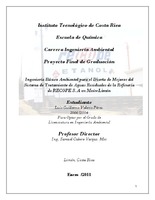Mostrar el registro sencillo del ítem
Ingeniería Básica Ambiental para el Diseño de Mejoras del Sistema de Tratamiento de Aguas Residuales de la Refinería de RECOPE S.A en Moín-Limón
| dc.contributor.advisor | Cubero-Vargas, Samuel | es |
| dc.contributor.author | Valerio-Pérez, Luis Guillermo | |
| dc.date.accessioned | 2015-09-01T17:46:46Z | |
| dc.date.available | 2015-09-01T17:46:46Z | |
| dc.date.issued | 2011 | |
| dc.identifier.uri | https://hdl.handle.net/2238/6267 | |
| dc.description | Proyecto de Graduación (Licenciatura en Ingeniería Ambiental) Instituto Tecnológico de Costa Rica. Escuela de Química, 2011. | es |
| dc.description.abstract | This project is a basic environmental engineering study carried out at the Refinería Costarricense de Petróleo (RECOPE SA). It is focused on providing design solutions with the purpose of improving the quality of the effluents generated by the wastewater treatment plant in one of its refineries located in Moín, Limón. This project also has the purpose of ensuring a healthy and ecologically balanced environment to the residents of the province. An environmental diagnosis was performed in the Wastewater Treatment Plant in order to develop this investigation and it was concluded that a Total Preventive Maintenance Program must be implemented in order to reduce downtime and inactivity of the production systems, caused by the malfunction of equipment currently available. In regards to the operational assessment of the equipment, the API Separator presented a high hydrocarbons´ removal efficiency for a total of 85.19% and very low suspended solids´ removal efficiency for a total of 16.39%. This issue is generated by some bad practices and the deterioration of certain equipment. On the other hand, the Hydrocarbons´ oxidation pond removal efficiency is 55.89%, which is lower than the theoretically expected 70% to 80%; this is because the retention time is not sufficient for degradation of pollutants. In order to improve the primary treatment, it was determined that the best option is to incorporate a Dissolved Air Flotation system (DAF) with coagulation‐flocculation. This was concluded after running a series of tests in laboratories that confirmed Chloride Ferric (Kemira PIX‐111) with a dose of 160 ppm as the best coagulant and cationic polyacrylamide (C‐CALLAWAY 4893) with a dose of 16 ppm as the best flocculant in terms of turbidity results in the wastewater. With regard to the improvements on the design of the current wastewater treatment system, a technical, financial and environmental analysis of the performance of two different and basic DAF systems was carried out. According to the results, the most feasible short and medium term option is the API Separator but it has to be modified, so that it operates as a DAF system by implementing saturation pumps and saturated water distributors in the separation chamber. Since the initial investment to operate it is low, significant savings could be obtained. Plus, additional space is not required as the existing infrastructure can be used. In addition, a redesign proposal of the existing oxidation pond, which would increase the efficiency in removing pollutants to 85%, is included in this document. | es |
| dc.description.sponsorship | Instituto Tecnológico de Costa Rica. Escuela de Química. | es |
| dc.language.iso | es | es |
| dc.publisher | Instituto Tecnológico de Costa Rica | es |
| dc.rights | acceso abierto | es |
| dc.subject | RECOPE S.A | es |
| dc.subject | Ingeniería básica ambiental | es |
| dc.subject | Remoción | es |
| dc.subject | Hidrocarburos | es |
| dc.title | Ingeniería Básica Ambiental para el Diseño de Mejoras del Sistema de Tratamiento de Aguas Residuales de la Refinería de RECOPE S.A en Moín-Limón | es |
| dc.type | proyecto fin de carrera | es |


